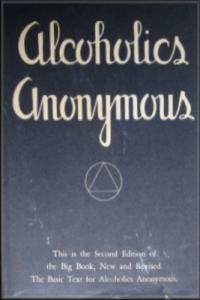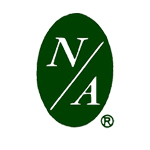
Alcoholics Anonymous (AA) is a global peer-led mutual aid fellowship begun in the United States dedicated to abstinence-based recovery from alcoholism through its spiritually inclined twelve-step program. AA's twelve traditions, besides stressing anonymity, establish it as free to all, non-professional, unaffiliated, and non-denominational as well as apolitical with a public relations policy of attraction rather than promotion. In 2020 AA estimated a worldwide membership of over two million, with 75% of those in the US and Canada.
Twelve-step programs are international mutual aid programs supporting recovery from substance addictions, behavioral addictions and compulsions. Developed in the 1930s, the first twelve-step program, Alcoholics Anonymous (AA), founded by Bill Wilson and Bob Smith, aided its membership to overcome alcoholism. Since that time dozens of other organizations have been derived from AA's approach to address problems as varied as drug addiction, compulsive gambling, sex, and overeating. All twelve-step programs utilize a version of AA's suggested twelve steps first published in the 1939 book Alcoholics Anonymous: The Story of How More Than One Hundred Men Have Recovered from Alcoholism.
Neurosis is a term mainly used today by followers of Freudian thinking to describe mental disorders caused by past anxiety, often that has been repressed. In recent history, the term has been used to refer to anxiety-related conditions more generally.
The Twelve Traditions of twelve-step programs provide guidelines for relationships between the twelve-step groups, members, other groups, the global fellowship, and society at large. Questions of finance, public relations, donations, and purpose are addressed in the traditions. They were originally written by Bill Wilson after the founding of the first twelve-step group, Alcoholics Anonymous (AA).
Recovery International is a mental health self-help organization founded in 1937 by neuropsychiatrist Abraham Low in Chicago, Illinois. Recovery's program is based on self-control, self-confidence, and increasing one's determination to act. Recovery deals with a range of people, all of whom have difficulty coping with everyday problems, whether or not they have a history of psychiatric hospitalization. It is non-profit, secular, and although it uses methods devised by Low, most groups are currently led by experienced non-professionals.
Higher Power is a term used in Alcoholics Anonymous (AA) and other twelve-step programs. The same groups use the phrases "a power greater than ourselves" and "God of our understanding" synonymously. The term is intentionally vague because the program is not tied to a particular religion or spiritual tradition; members may use it to refer to any supreme being or deity, another conception of God, or even non-supernatural things such as the twelve-step program itself.
Clutterers Anonymous (CLA) is a twelve-step program for people who share a common problem with accumulation of clutter. CLA says that it focuses on the underlying issues made manifest by unnecessary physical and emotional clutter, rather than hints, tips and lectures. CLA had active meetings in about 70 cities in 24 states in the US, and several in England, Germany, and Iceland, as of 2011. CLA Tradition 3 states, "The only requirement for CLA membership is a desire to stop cluttering." Clutterers Anonymous replaces "powerless over alcohol" in the First Step of the Twelve Steps originally developed by Alcoholics Anonymous (AA) with "powerless over our clutter." CLA was founded in May 1989 in Simi Valley, California. Some members of CLA describe the inability to let go of objects as a consequence of spiritual emptiness.

Emotions Anonymous (EA) is a twelve-step program for recovery from mental and emotional illness. As of 2017 there were approximately 300 Emotions Anonymous groups active in the United States and another 300 around the world.
Overeaters Anonymous (OA) is a twelve-step program founded by Rozanne S. Its first meeting was held in Hollywood, California, USA on January 19, 1960, after Rozanne attended a Gamblers Anonymous meeting and realized that the Twelve Steps could potentially help her with her own addictive behaviors relating to food. OA has since grown, with groups in over 75 countries meeting in person, over the phone, and through the internet. OA is for people with problems related to food including, but not limited to, compulsive overeaters, those with binge eating disorder, bulimics and anorexics. Anyone with a problematic relationship with food is welcomed; OA's Third Tradition states that the only requirement for memberships is a desire to stop eating compulsively.
Al-Anon Family Groups, founded in 1951, is an international mutual aid organization for people who have been impacted by another person's alcoholism. In the organization's own words, Al-Anon is a "worldwide fellowship that offers a program of recovery for the families and friends of alcoholics, whether or not the alcoholic recognizes the existence of a alcohol-related problem or seeks help." Alateen "is part of the Al-Anon fellowship designed for the younger relatives and friends of alcoholics through the teen years".
Debtors Anonymous (DA) is a twelve-step program for people who want to stop incurring unsecured debt. Collectively they attend more than 500 weekly meetings in fifteen countries, according to data released in 2011. Those who compulsively incur unsecured debt are said to be engaged in compulsive borrowing and are known as compulsive debtors.
Sex and Love Addicts Anonymous (SLAA) is a twelve-step program for people recovering from sex addiction and love addiction. SLAA was founded in Boston, Massachusetts in 1976, by a member of Alcoholics Anonymous (AA). Though he had been a member of AA for many years, he repeatedly acted out and was serially unfaithful to his wife. He founded SLAA as an attempt to stop his compulsive sexual and "romantic" behavior. SLAA is also sometimes known as the Augustine Fellowship, because early members saw many of their shared symptoms described by St. Augustine of Hippo in his work Confessions. COSLAA is another twelve-step fellowship created to support the family members and friends of sex and love addicts.
Grow is a peer support and mutual-aid organization for recovery from, and prevention of, mental illness.
Co-Dependents Anonymous (CoDA) is a twelve-step program for people who share a common desire to develop functional and healthy relationships. Co-Dependents Anonymous was founded by Ken and Mary Richardson and the first CoDA meeting attended by 30 people was held October 22, 1986 in Phoenix, Arizona. Within four weeks there were 100 people and before the year was up there were 120 groups. CoDA held its first National Service Conference the next year with 29 representatives from seven states. CoDA has stabilized at about a thousand meetings in the US, and with meetings active in 60 other countries and dozens online that can be reached at www.coda.org.
Self-help groups for mental health are voluntary associations of people who share a common desire to overcome mental illness or otherwise increase their level of cognitive or emotional wellbeing. Despite the different approaches, many of the psychosocial processes in the groups are the same. Self-help groups have had varying relationships with mental health professionals. Due to the nature of these groups, self-help groups can help defray the costs of mental health treatment and implementation into the existing mental health system could help provide treatment to a greater number of the mentally ill population.
Drug addiction recovery groups are voluntary associations of people who share a common desire to overcome their drug addiction. Different groups use different methods, ranging from completely secular to explicitly spiritual. Some programs may advocate a reduction in the use of drugs rather than outright abstention. One survey of members found active involvement in any addiction recovery group correlates with higher chances of maintaining sobriety. Although there is not a difference in whether group or individual therapy is better for the patient, studies show that any therapy increases positive outcomes for patients with substance use disorder. The survey found group participation increased when the individual members' beliefs matched those of their primary support group. Analysis of the survey results found a significant positive correlation between the religiosity of members and their participation in twelve-step programs and to a lesser level in non-religious SMART Recovery groups, the correlation factor being three times smaller for SMART Recovery than for twelve-step addiction recovery groups. Religiosity was inversely related to participation in Secular Organizations for Sobriety.
Women for Sobriety (WFS) is a non-profit secular addiction recovery group for women with addiction problems. WFS was created by sociologist Jean Kirkpatrick in 1976 as an alternative to twelve-step addiction recovery groups like Alcoholics Anonymous (AA). As of 1998 there were more than 200 WFS groups worldwide. Only women are allowed to attend the organization's meetings as the groups focus specifically on women's issues. WFS is not a radical feminist, anti-male, or anti-AA organization.

Alcoholics Anonymous: The Story of How More Than One Hundred Men Have Recovered from Alcoholism is a 1939 basic text, describing how to seek recovery from alcoholism. The Big Book was written by William G. "Bill W." Wilson, one of the founders of Alcoholics Anonymous, with the help of various editors. The composition process was not collaborative other than editing. Bill wrote all of the chapters except for "To Employers" which was written by Bill's right hand man, Hank Parkhurst. Parkhurst influenced the more liberal notions of "God as we understand him" and "your own conception of God." Drafts of sections were sent back and forth between Bill W.'s group in New York and Robert Holbrook Smith, the other AA founder, in Akron, Ohio. Dr. Bob made no major changes. It is the predecessor of the seminal "twelve-step method" widely used to treat many addictions, from alcoholism, heroin addiction and marijuana addiction to overeating, sex addiction and gambling addiction, with a strong spiritual and social emphasis. It is one of the best-selling books of all time, having sold 30 million copies. In 2011, Time magazine placed the book on its list of the 100 best and most influential books written in English since 1923, the year in which the magazine was first published. In 2012, the Library of Congress designated it as one of 88 "Books that Shaped America."
Underearners Anonymous (UA) is a twelve-step program founded in 2005 for men and women who have come together to overcome what they call "underearning". Underearning is not just the inability to provide for oneself monetarily including the inability to provide for one's needs presently and in the future but also the general inability to express one's capabilities and competencies. The underlying premise of Underearners Anonymous is that underearning is a kind of mental disorder regarding the use of time, rather like the alcoholic's self-destructive compulsion to drink to excess.





